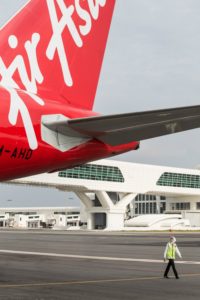Even planes need some Tender Loving Care. Captain Lim Khoy Hing explains the strict care required to keep aircraft airworthy.

Engineers working on a jet engine during routine aircraft maintenance.
I remember a British TV station once broadcasting footage showing how AirAsia X’s Airbus A340 executed an efficient turnaround and departed safely within 90 minutes of landing in London Stansted Airport. “Doesn’t the plane ever need a rest after the 13-hour journey from Kuala Lumpur?” asked one passenger.
Unlike human beings, who need rest, airplanes are designed to remain operational most of the time. Aircraft only need a short ‘rest’ in between flights to replenish oil and fuel; during this break, flight crew conduct various checks including a walk-around check of the plane, while engineers perform their own inspections.
Airlines prefer planes to be in the air as much as possible until they are due for maintenance at pre-set intervals – this scheduled maintenance can be considered the ‘rest’ period for aircraft.
A plane has to meet stringent regulatory maintenance requirements that are far more meticulous than those imposed on the average car. As such, pilots must conduct certain external checks prior to every flight. During boarding, you might have noticed the captain or first officer leaving the cockpit for a walk around the plane to inspect, among others, the brakes, tires and engines. To ensure that the aircraft is safe for departure, they also check for any signs of damage that may be caused by the rigours of flying – similar to the wear and tear on a car.
Similar checks are also performed by an engineer. When the captain signs the acceptance of the plane, he is generally satisfied with the airworthiness of his machine for a safe flight.

An AirAsia pilot conducting a walk around check before take-off.
Safety First
In addition to the checks conducted before every flight, the plane also undergoes maintenance known as an ‘A Check’ every 8 to 10 weeks. This is when filters are replaced, vital flight systems are lubricated and a detailed inspection of all equipment is done.
Subsequently, a ‘C Check’ is conducted every one and a half to two years. This takes about three weeks to complete and the plane ‘rests’ during this time, parked inside a maintenance hangar.
And finally, a ‘D Check’ – considered heavy maintenance, where the entire aircraft is dismantled and reassembled again – is performed every six years. During this check, the most stressed systems, especially the engines and landing gears, are removed and overhauled.
Additionally, all other systems are taken apart and repaired or replaced. So, by the end of the ‘D Check’, the plane is practically as good as new!
How Old is Too Old?
Some of you might be wondering how many ‘D Checks’ are carried out before an aircraft is considered too old to fly. The general consensus is that a long-haul airplane can safely fly for 30 years before it is retired from flying. For instance, a Boeing 747 is normally retired after about 27 years of service, whereas other wide-body planes like the Tri-Star have a shorter life span of around 24 years.
Normally, short-haul planes, which do more take-offs and landings, have a shorter life span than long-haul planes. The main reason for this is that an airplane’s life span is determined by its pressurisation cycles. A plane’s pressurised cabin is just like a balloon, and the frequency of expansion and contraction during the pressurisation process inflicts stress on the body; the frequency of this is more on short-haul flights than in long-haul air travel.
Time is Money
The philosophy behind a quick turnaround is that the longer a plane stays on the ground, the greater the cost for the airline, simply because ‘time is money’. Hence, a quick turnaround is crucial in the airline business.
On the Airbus A340 that I used to operate many years ago, we managed to accomplish many tasks during the quick turnaround in London – about 100 tonnes of fuel were pumped into aircraft tanks; passengers were efficiently disembarked, and their luggage and cargo unloaded; the cabin, cleaned; food, replenished; and about 300 passengers boarded for the return flight to Kuala Lumpur. This was all achieved within that short 90-minute window; otherwise, we would have lost our departure time slot, causing a delay.

Image Source: Travel 3Sixty
Refuelling is one of the many tasks accomplished during the quick turnaround between flights.
Matter of Logic
Considering the cost of buying and operating an airplane, a quick turnaround to keep the aircraft flying for as long as possible is logical; of course, paramount is ensuring proper maintenance. Through it all, air safety remains our top priority. Fortunately, planes aren’t like humans, otherwise air travel would be far more expensive and less frequent than it is now.
I hope you have enjoyed this month’s article, and you now know that it is perfectly alright to travel on an aircraft even if it looks a little dated, as stringent checks and maintenance procedures keep the planes in the sky safe and airworthy.
With that I wish you a pleasant and comfortable flight!
Posted: 10.07.18